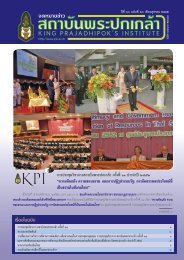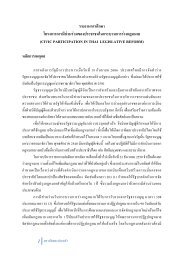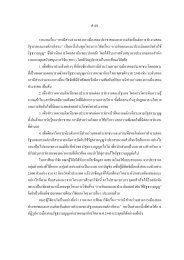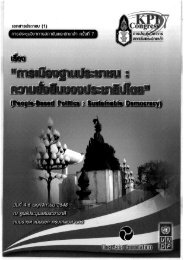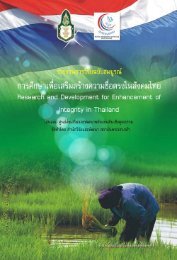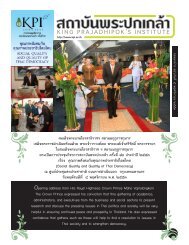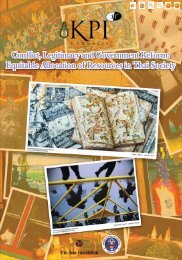SUFFiciENcy EcONOMy ANd GRASSROOtS DEvElOPMENt
SUFFiciENcy EcONOMy ANd GRASSROOtS DEvElOPMENt
SUFFiciENcy EcONOMy ANd GRASSROOtS DEvElOPMENt
Create successful ePaper yourself
Turn your PDF publications into a flip-book with our unique Google optimized e-Paper software.
The Meaning of Sufficiency Economy <br />
International Conference<br />
219<br />
Rice seed was first planted in seed beds and then the stalks were pulled up to plant<br />
in the fields. Supplementary foods included some garden crops, bamboo shoots,<br />
other plants and insects collected from the forest. The most important protein in the<br />
diet came from fish which were either caught by men or raised in ponds.<br />
Women not only were co-workers in agriculture, but they assumed<br />
responsibility for converting raw food, especially rice, into cooked food for<br />
consumption. At the time most village women converted rice paddy through use of a<br />
mortar and pestle mill. The staple was glutinous rice which women steamed in the<br />
morning for consumption during the day and then prepared new rice again at night. <br />
Women in Bãn Nông Tün pounding rice using a mortar and pestle, 196<br />
3 (photo by Jane Keyes)<br />
The village was not only self-sufficient in foodstuffs, but almost all clothing<br />
and utensils were also produced by villagers. Women produced all clothing worn<br />
from silk and cotton raised in village fields. Men, in addition to their work in the<br />
fields and in fishing (and very limited hunting), devoted their energies primarily to<br />
producing utensils out of bamboo and rattan. Men were also responsible for building<br />
and repairing houses.<br />
Village houses were made out of wood from trees cut in the forest, woven<br />
bamboo, and atap. However, one of the few items purchased by villagers was<br />
corrugated iron roofing and the iron used for metal tools.<br />
In short, the economic characteristics of Ban Nông Tün, like those of most Isan<br />
villages in the 1960s, exemplified what would today be termed a sufficiency<br />
economy. These characteristics were closely interwoven with the religious<br />
characteristics of the village.<br />
A Moral Community<br />
The village was a ‘moral community’ united by common worship of village<br />
spirits at the ‘navel of the village’ (bübãn) and ancestral spirits (phî pûtã) who<br />
resided in their own forest on the edge of the village. Offerings were made annually<br />
at these shrines.<br />
More importantly, villagers were united in their support of the local wat or<br />
Buddhist temple-monastery. Almost every village male ordained as a monk at the<br />
age of 20 for at least 3 months and often for two ‘lents’ (phansã). Many boys also<br />
spent time as novices at the wat. The monks and novices were central for the<br />
observance of an annual cycle of rituals.<br />
Preparations for a ritual the wat (Buddhist temple-monastery), 1963<br />
(photo by Jane Keyes)



